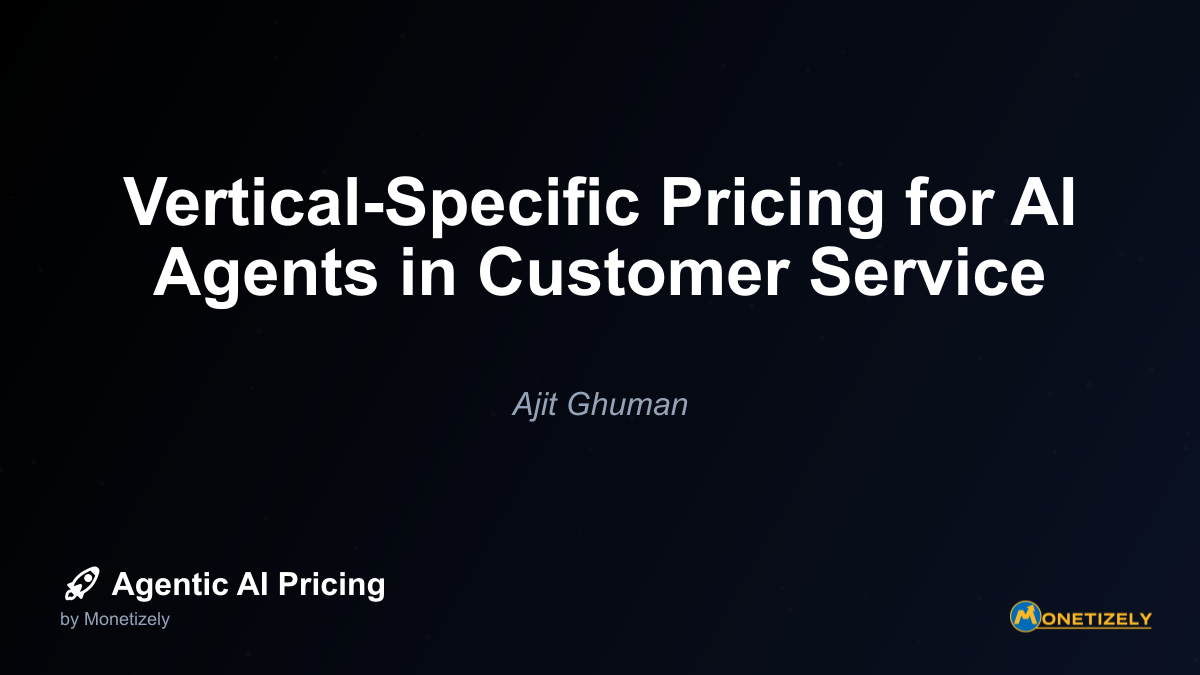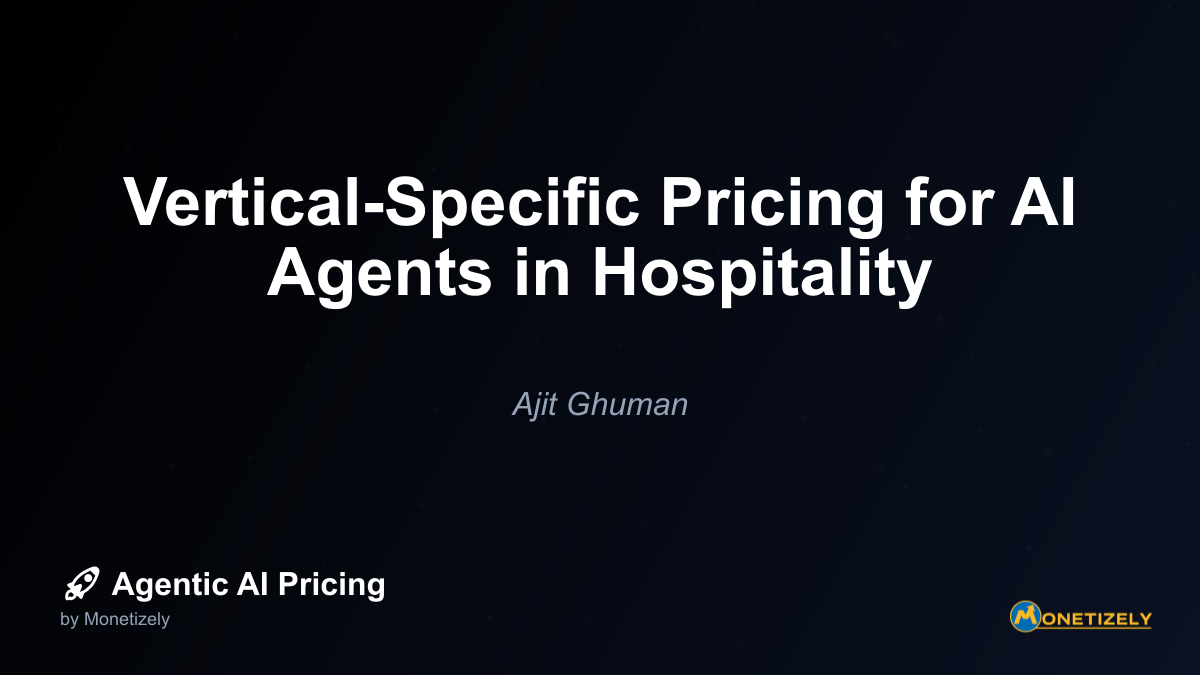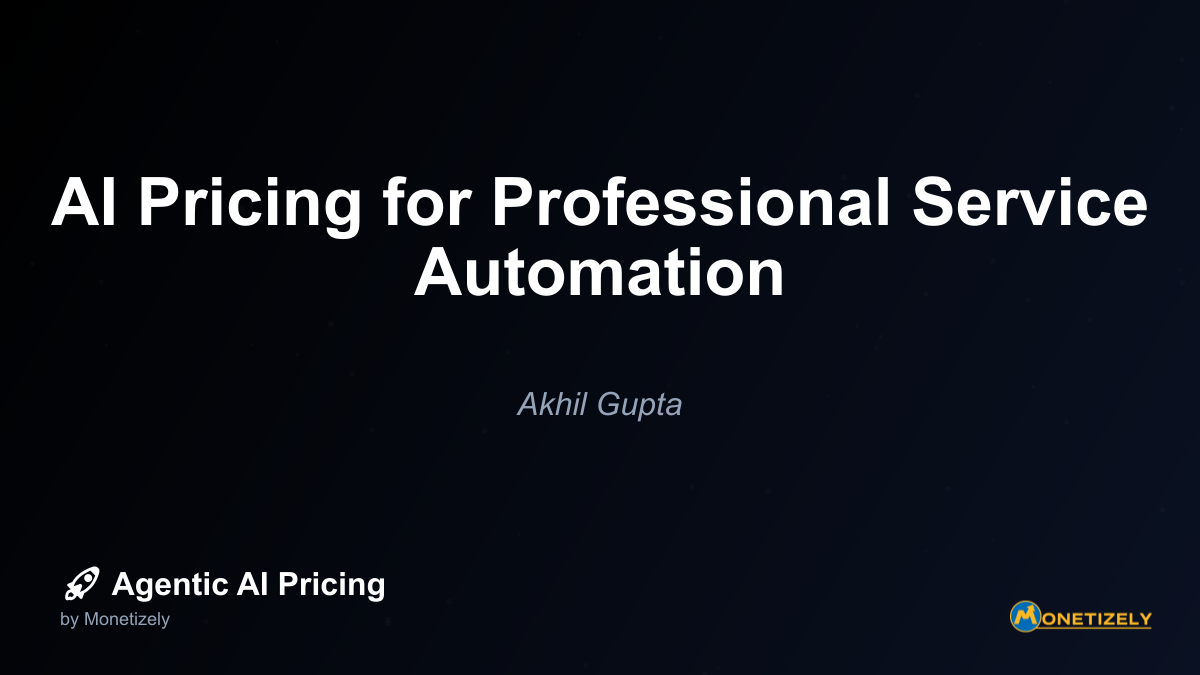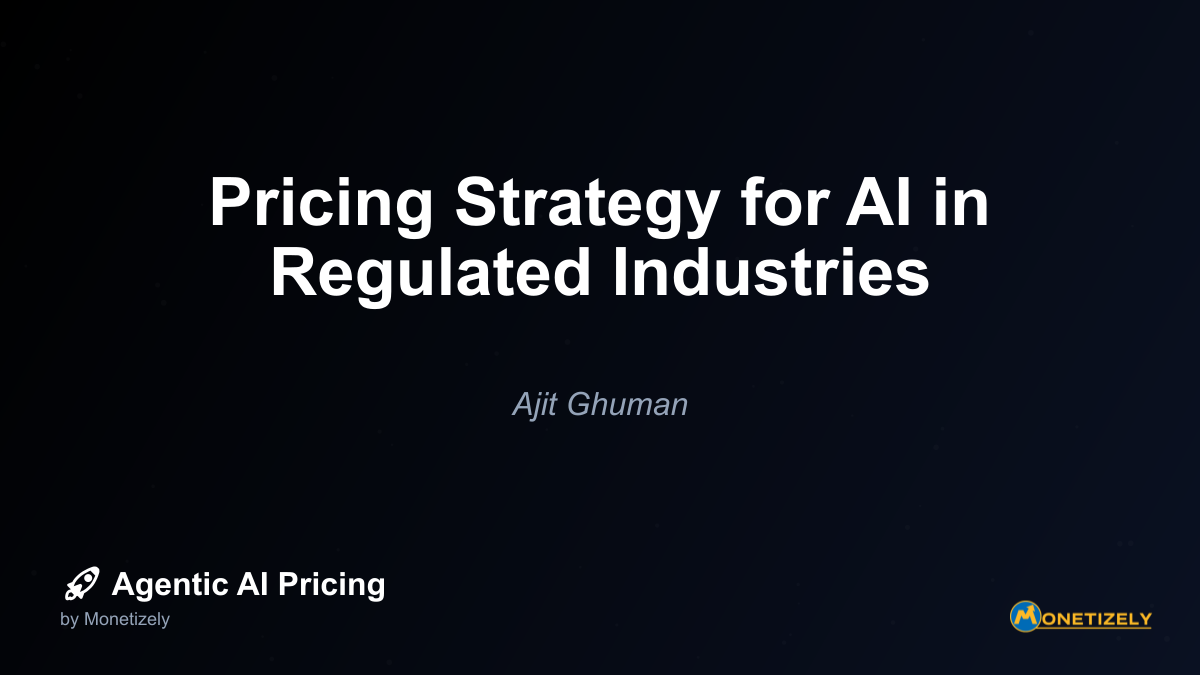· Ajit Ghuman · Industry-Specific · 13 min read
Vertical-Specific Pricing for AI Agents in Telecommunications
AI and SaaS Pricing Masterclass
Learn the art of strategic pricing directly from industry experts. Our comprehensive course provides frameworks and methodologies for optimizing your pricing strategy in the evolving AI landscape. Earn a professional certification that can be imported directly to your LinkedIn profile.
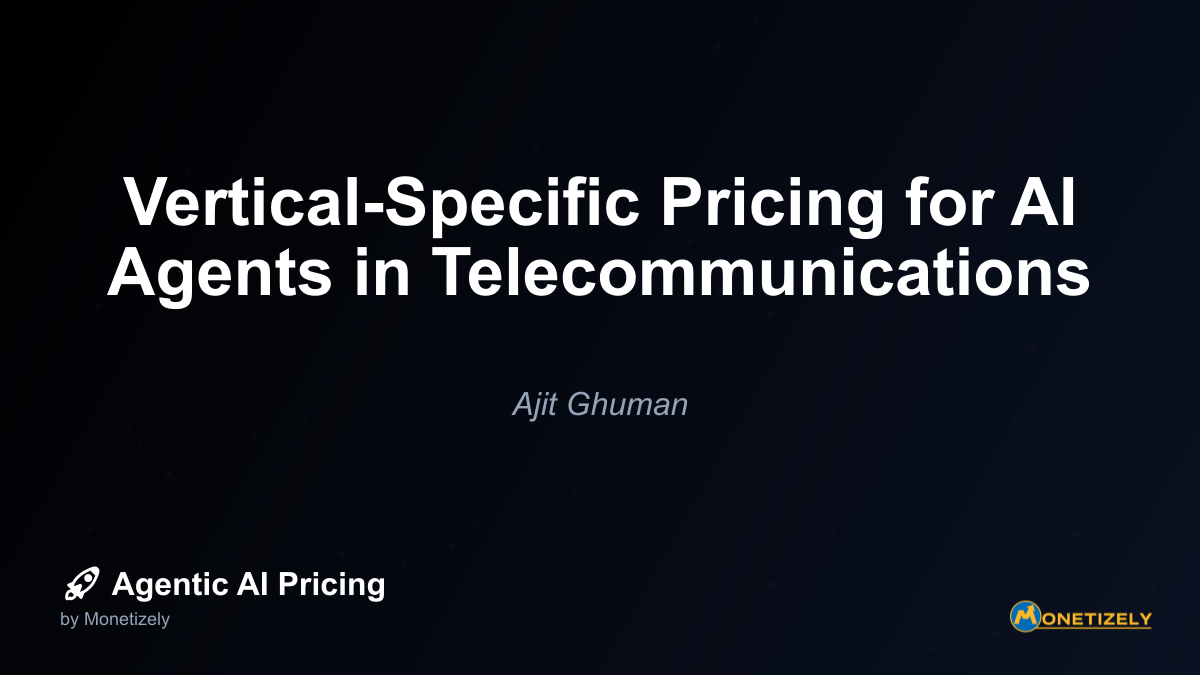
The telecommunications industry stands at the forefront of AI transformation, with agentic AI solutions revolutionizing everything from network infrastructure to customer interactions. As telecom providers increasingly deploy AI agents to optimize operations and enhance service delivery, developing effective pricing strategies becomes critical for both vendors and operators. This deep dive explores the nuanced approaches to vertical-specific pricing for AI agents in telecommunications, with a focus on network optimization and customer service applications.
The Evolving Landscape of AI in Telecommunications
Telecommunications companies are rapidly integrating AI across their operations, driven by the need to optimize increasingly complex networks, manage vast data volumes, and deliver superior customer experiences. The AI in telecommunication market is experiencing explosive growth, valued at approximately $2.36 billion in 2023 and projected to reach over $4.4 billion in 2024, with a potential to exceed $102 billion by 2033. This represents a compound annual growth rate (CAGR) of around 40.6% from 2025 to 2033.
Adoption rates are equally impressive, with about 90% of telecom companies having integrated AI in some form, with 48% piloting and 41% actively deploying AI solutions. North America currently dominates with approximately 28% market share, driven by advanced infrastructure and early AI adoption.
The telecom sector presents unique challenges and opportunities for AI implementation, particularly in two critical areas:
Network Optimization: AI agents enable self-optimizing networks that dynamically adjust routing and resources based on real-time conditions, detect network issues, and systematically diagnose root causes autonomously. This allows operators to reduce operational costs while maintaining or improving network reliability.
Customer Service: Virtual assistants and AI chatbots handle installation, maintenance, troubleshooting, and claims efficiently, driving significant improvements in customer satisfaction. For example, Vodafone’s TOBi chatbot improved customer experience by approximately 68%.
As these applications mature, the pricing models for AI agents in telecommunications are evolving beyond traditional approaches to reflect the unique value and requirements of the industry.
Current AI Agent Pricing Models in Telecommunications
The telecommunications industry is witnessing a transformation in AI agent pricing models, moving from conventional fixed-fee structures toward more sophisticated approaches that align costs with value delivery and usage patterns.
Agent-Based Pricing Model
This model involves customers purchasing individual AI agents through subscriptions or one-time fees, often reflecting a salary-like cost for digital labor. For example, high-level AI research agents may command approximately $20,000 per month, paralleling human salary structures.
The agent-based model offers clear budget predictability and simplifies the reallocation of traditional human labor costs to AI agents. It’s particularly favored by vendors and customers seeking cost transparency and steady budgeting for AI deployments at scale.
Usage-Based Pricing
Under this model, pricing depends on actual resource consumption, such as cloud compute power, GPU hours, number of inference calls, or data processed. For instance, GPU-as-a-Service (GPUaaS) in telecom carriers’ AI infrastructures may be billed by the hour or minute for compute power consumed, reflecting spot contracts or reserved capacities.
Usage-based models align costs with actual AI workload and promote scalability. However, they often lack cost predictability, making them less favorable for customers deploying AI at scale due to fluctuating costs and unclear value linkage.
Outcome-Based Pricing
This increasingly popular approach ties pricing directly to the results or value generated, such as savings from network optimization or improvements in customer service metrics. Examples include percentage improvements in network uptime, customer satisfaction scores, or cost savings generated by AI-enabled automation.
Outcome-based pricing requires precise outcome measurement and attribution but effectively aligns costs with ROI. Telecom applications include efficiency gains, fraud prevention, or reductions in customer service workload.
Agent Swarm / Subscription Models
Enterprises pay for bundles of agents customized to their task complexity, such as multiple AI agents working collaboratively. These models are scalable and customizable but may risk underutilization or complex tiering.
Telecom-Specific Pricing Innovations (2023-2025)
The telecommunications industry has developed several innovative pricing approaches tailored to its unique requirements:
AI-RAN Pricing
Telcos investing in AI-RAN (AI integrated with radio access networks) are implementing flexible pricing models based on total cost of ownership and expected revenue gains from AI workloads. Pricing is influenced by balancing higher AI-capable hardware costs with projected efficiency and monetization benefits.
Hybrid AIaaS and Connectivity Bundles
Some telecom companies are launching bundles that combine AI services with connectivity packages. For example, integrating AI-driven customer analytics or predictive maintenance tools with 5G/6G service plans represents a novel approach to pricing AI solutions as part of broader telecom offerings.
Edge AI Platform Pricing
Deploying AI models on telco edge infrastructure often involves a combination of subscription fees plus usage meters based on inference volume, model complexity, or data throughput. Telcos leverage edge computing infrastructure for low-latency AI inference, charging accordingly.
Data Monetization with Privacy
Some pricing models include fees for access to anonymized network data sets used to train AI models or deliver insights, balanced by privacy safeguards. This creates additional revenue streams related to AI without direct service fees.
Case Studies: AI Agent Implementation in Telecommunications
Examining real-world implementations provides valuable insights into how pricing models function in practice.
AT&T’s Virtual Assistant
AT&T deployed an AI-powered virtual assistant for customer service that manages millions of queries 24/7, reducing wait times and operational costs significantly. The system uses machine learning to personalize interactions and AI analytics to optimize processes, boosting customer satisfaction and service quality.
While specific pricing details aren’t publicly disclosed, AT&T’s solution likely follows a SaaS or subscription-based pricing model for AI platform usage, integrated with existing customer relationship management (CRM) systems. The implementation achieved significant operational cost reductions, increased customer satisfaction scores, and faster query handling times.
Samsung & SK Telecom’s AI-RAN Parameter Recommender
Samsung and SK Telecom launched the AI-RAN Parameter Recommender system in 2024 to optimize 5G network parameters such as beamforming and transmission power. This AI-driven solution increased downlink throughput by 24%, cut latency by 15-20%, and saved energy without hardware upgrades.
The system is software-based, leveraging existing network data and infrastructure, avoiding high capital expenditure on hardware upgrades. Pricing specifics aren’t disclosed publicly but emphasize software and integration costs rather than new physical assets.
Telefonica’s Predictive Maintenance
Telefonica employs AI-driven predictive maintenance and network issue detection in fiber networks, scheduling repairs proactively during low-traffic periods to minimize downtime and cost. They have created over 500 AI tools improving robustness and customer satisfaction.
This implementation demonstrates the value of outcome-based pricing models, where the cost of AI solutions can be directly tied to measurable improvements in network reliability and operational efficiency.
T-Mobile’s IntentCX
T-Mobile partnered with OpenAI in 2024 to develop IntentCX, an AI platform that predicts customer intent and proactively resolves issues using billions of customer interaction data points, delivering instant tailored support and improved customer journeys.
This implementation likely uses a hybrid pricing model combining subscription fees with outcome-based components tied to improvements in customer satisfaction and service efficiency.
Technical Architecture and Infrastructure Requirements
The technical requirements for deploying AI agents in telecommunications significantly influence pricing models and must be considered when developing pricing strategies.
Network Integration and Architecture
AI agents operate within a multi-agent system embedded into the telecom network architecture, where agents representing network components and user equipment collaborate and share resources dynamically. This is particularly envisioned for 6G networks.
The architecture typically includes a centralized control plane for authorization, context, and visibility, and a peer-to-peer encrypted data plane for high-speed, ephemeral agent-to-agent communication. This supports real-time decision-making without heavy device-by-device provisioning.
Data Requirements
Successful AI agent deployment depends on access to rich, diverse, and meticulously curated multi-domain data from various sources, including:
- Network performance KPIs (latency, jitter, bandwidth)
- Customer usage behavior
- Billing and call detail records
- Customer sentiment data
Real-time packet-based data streams are essential to achieve visibility into network status and enable actionable insights. Data must cover multiple network domains such as RAN (Radio Access Network), CORE, MEC (Multi-access Edge Computing), and transport layers for comprehensive agent training and operation.
Computing Resources
AI agents require scalable compute infrastructure capable of handling multi-modal data streams and real-time analytics. This includes high-performance processing capabilities distributed across network edge and core to minimize latency and ensure service continuity.
The system demands resource orchestration mechanisms to allocate memory, compute, connectivity, and specialized toolboxes dynamically in response to agent interactions and network conditions. Edge computing integration is significant for latency-sensitive applications, enabling AI agents to perform localized data processing and decision-making close to users.
Integration with Legacy Systems
Legacy telecom networks, designed for static applications and deterministic traffic patterns, pose challenges due to their hardware-centric, license-driven pricing models and policy-based appliances. Agentic AI architectures advocate a shift towards stateless networking, minimizing device provisioning overhead and enabling consumption-based pricing models aligned with dynamic AI workloads.
This transition requires overlay or hybrid approaches where AI agents interface with legacy control planes and gradually introduce intelligent automation without disrupting existing services.
Measuring ROI and Building the Business Case
Establishing clear ROI metrics is essential for justifying AI agent investments and developing appropriate pricing models in telecommunications.
Key Metrics for Measuring Success
- Cost reduction: Lower total cost per call by replacing human agents with AI for routine Tier 1 calls (from about $4–7 down to ~$1 per call)
- Operational efficiency: Decreased average handle time (up to 42% reduction), faster issue resolution (first-call resolution rising from < 60% to 78%), and reduced average hold times (over 1 minute reduction)
- Customer satisfaction: Increases in customer satisfaction scores (e.g., +30-34%) and faster response times (sometimes 80-90% improvement)
- Revenue impact: ARPU (Average Revenue Per User) gains between 5% and 20% through AI-driven cross-selling and upselling, leads pipeline growth (e.g., £80 million in six months), and higher lead conversion rates (up to 50% improvement in B2B)
- Network reliability: Decreased downtime with predictive maintenance detecting failures before they occur, prolonging equipment life and lowering OPEX
- Scalability: 24/7 availability reduces need for seasonal hiring and improves service consistency, enabling scaling without proportional increase in human staff
Cost-Benefit Analysis Frameworks
Effective pricing models should consider these frameworks for assessing AI agent value:
- Labor cost savings: Comparing human agent costs per contact with AI agent costs, estimating savings from automated handling of repetitive queries
- Efficiency and speed gains: Quantifying reduction in handle time and call volume routed to humans, plus impact on customer wait times and hold times
- Revenue uplift modeling: Using AI insights for cross-sell/upsell impact on ARPU and incremental pipeline value
- Customer retention and satisfaction valuation: Improved CSAT scores and first-call resolution are linked to churn reduction and lifetime value gains
- Operational risk mitigation: Predictive maintenance lowering unexpected outages, saving costs related to downtime and equipment failure
Proven ROI Examples
- Vodafone’s TOBi virtual assistant: Handles 45 million conversations monthly, significantly reducing hold times by over one minute and improving customer satisfaction through personalized, fast responses
- Major telecom AI call center: Reduced average handle time by 42%, increased first-call resolution from < 60% to 78%, lifted customer satisfaction by 34%, and saved about $3.2 million annually
- Telco predictive maintenance: AI systems monitored network equipment to forecast failures, minimizing downtime and operational costs
- Cross and upselling AI insights: One provider boosted B2B lead conversion by 50% and added £80 million to sales pipeline in six months through AI-driven customer analytics
Developing Vertical-Specific Pricing Strategies for Telecom
Based on the unique characteristics of the telecommunications industry and the specific applications of AI agents, we can identify several strategic approaches to pricing.
Strategic Framework for AI Agent Pricing in Telecommunications
1. Align Pricing with Network Value Chain
Telecommunications networks consist of multiple layers, each with different value propositions:
- Access Layer: AI agents that optimize the last mile and customer connectivity
- Transport Layer: AI solutions for backbone and middle-mile optimization
- Service Layer: AI applications for customer experience and service delivery
Pricing strategies should reflect the value delivered at each layer, with potentially different models for different network segments. For example, outcome-based pricing may be more appropriate for service layer applications, while subscription or agent-based pricing might better suit transport layer optimization.
2. Scale-Based Tiering
Telecommunications networks operate at massive scale, making scalability a critical consideration:
- Entry Tier: Limited AI agent deployment for specific use cases or network segments
- Mid-Tier: Expanded deployment across multiple network domains or customer segments
- Enterprise Tier: Full-scale implementation across the entire network and customer base
Each tier should offer appropriate pricing discounts for scale while ensuring sustainable margins for vendors.
3. Hybrid Models for Complex Use Cases
Many telecom AI applications span multiple domains and deliver value in different ways:
- Base Subscription: Core AI agent functionality with predictable monthly costs
- Usage Components: Variable charges for compute-intensive tasks or high-volume processing
- Outcome Bonuses: Additional fees tied to specific performance improvements or cost savings
This approach provides budget predictability while aligning incentives for continuous improvement.
Network Optimization Pricing Strategies
For AI agents focused on network optimization, consider these specialized approaches:
1. Performance Improvement Pricing
Directly tie pricing to measurable network performance enhancements:
- Percentage improvement in throughput or latency
- Reduction in network congestion or packet loss
- Energy efficiency gains and carbon footprint reduction
For example, a vendor might charge a base fee plus a percentage of documented cost savings from reduced energy consumption or improved spectrum efficiency.
2. Predictive Maintenance Value Capture
For AI agents that predict and prevent network failures:
- Reduction in network downtime (minutes/hours avoided)
- Extended equipment lifespan (delayed CapEx)
- Maintenance cost reduction (fewer truck rolls or site visits)
Pricing could include a base monitoring fee plus shared savings from avoided downtime costs or extended equipment life.
3. Spectrum Efficiency Premium
For AI solutions that optimize spectrum usage in wireless networks:
- Increased capacity without additional spectrum acquisition
- Dynamic spectrum allocation based on real-time demand
- Interference reduction and signal quality improvement
Pricing might be tied to the cost avoidance of additional spectrum purchases or the value of increased capacity.
Customer Service AI Agent Pricing Strategies
For AI agents focused on customer service applications, consider these specialized approaches:
1. Volume-Based Conversation Pricing
Tiered pricing based on the volume of customer interactions handled:
- Per-conversation fees with volume discounts
- Monthly conversation packages with overage charges
- Unlimited conversation plans for predictable budgeting
This approach is straightforward to implement and understand but may not fully capture the value of improved customer experience.
2. Deflection-Based Savings Share
Pricing tied to the reduction in human agent workload:
- Percentage of calls successfully handled without human intervention
- Reduction in average handle time for human agents
- Decrease in total contact center staffing requirements
For example, the vendor might receive a percentage of documented labor cost savings achieved through AI automation.
3. Customer Satisfaction Premium
Pricing linked to improvements in customer experience metrics:
- Net Promoter Score (NPS) increases
- Customer Satisfaction (CSAT) improvements
- Reduction in churn attributed to service improvements
This approach directly aligns pricing with the ultimate goal of customer service improvements but requires sophisticated attribution modeling.
Implementation Challenges and Considerations
Implementing effective pricing strategies for AI agents in telecommunications faces several challenges that must be addressed:
Integration Complexity
The integration of AI agents with heterogeneous legacy network infrastructures and multiple vendors, especially for network optimization, demands adherence to standards like O-RAN. This complexity can impact implementation costs and affect the viability of certain pricing models.
Recommendation: Include integration complexity factors in pricing tiers, with premiums for environments requiring extensive customization or legacy system integration.
Data Privacy and Security
Ensuring data privacy and security during AI-driven customer interactions and predictive analytics remains a critical concern for telecom providers. Regulatory requirements add another layer of complexity.
Recommendation: Include compliance and security capabilities as value-added components in pricing structures, with clear delineation of responsibilities between vendor and operator.
Model Accuracy and Maintenance
Managing the complexity of AI models and continuous training with live network data to maintain accuracy and relevance is an ongoing challenge.
Recommendation: Include model retraining and accuracy guarantees in pricing structures, potentially with performance-based components tied to sustained accuracy levels.
Initial Skepticism and Budget Allocation
Telecom executives may show initial skepticism and reluctance in budget allocation, requiring proof-of-concept successes to drive investments.
Recommendation: Offer low-risk entry points with proof-of-concept pricing that transitions to full-scale implementation models based on validated results.
Future Trends in AI Agent Pricing for Telecommunications (2024-2026)
The landscape of AI agent pricing in telecommunications is expected to evolve significantly in the near future, driven by several key trends:
Rapid Market Growth and Investment
The global agentic AI in telecom market is forecasted to grow explosively, from $3
Co-Founder & CEO
Ajit is the author of Price To Scale, a top book on SaaS Pricing and is the Founder of Monetizely. Ajit has led and worked in pricing and product marketing at firms like Twilio, Narvar and Medallia. His work has been featured in Forbes and VentureBeat. Ajit regularly consults with software companies from Seed stage to post-IPO on pricing strategy. Ajit is also a highly-rated co-instructor for 'The Art of SaaS Pricing and Monetization' on Maven.
Pricing Strategy Audit
Let our experts analyze your current pricing strategy and identify opportunities for improvement. Our data-driven assessment will help you unlock untapped revenue potential and optimize your AI pricing approach.

